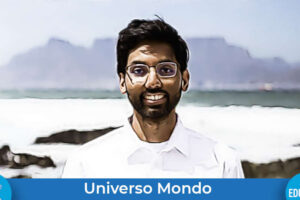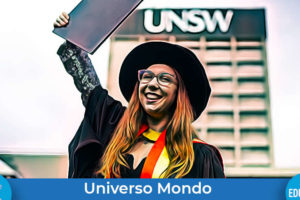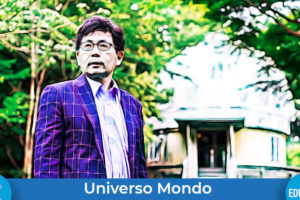Aggiornato il 28 Novembre 2024
Our column this month travels to one of the best places on planet Earth to observe the night sky and investigate the universe: Chile. There, we meet Ricardo Garcàa Soto, a science communicator and audiovisual producer who combines his passions for astronomy and filmmaking, creating compelling stories to inspire Chilean and international audiences with the wonders of science and the cosmos.

As usual in this series, let’s start from your path: can you describe your current occupation and what led you there?
I call myself a science communicator but I’m a filmmaker. When I was a kid I dreamed about being an astronomer, I loved to watch the night sky and at 13 years old I got my first telescope, so when I went to the university I studied astronomy. The thing is that I wasn’t enjoying it, and when I was doing an internship at Cerro Calà¡n Observatory I realised that research was not for me: I still loved astronomy, but the work an astronomer does was not fulfilling for me. It was a very tough moment in my life and that is why I changed completely and I pursued another passion of mine when I was a kid, filmmaking.
It was a test for me, to see if that was what I wanted to do or not, so I started studying filmmaking in the same University. After a few months I was in love with it.
For a while I put astronomy aside and focused on cinema. After a few years, while I was still studying filmmaking, I started working at a touristic observatory in Santiago, and it was there where I realised that I could combine my two passions into one, because what I loved about astronomy was not research but communicating it. So, finally, every piece of the puzzle that was my life came together.
Your background is distinctive, with degrees both in astronomy and in cinema. How did both passions start for you and how did you manage to combine them in your job?
I don’t have a degree in astronomy, I studied for 4 and a half years but I needed a few more courses to get a degree. I don’t regret it a bit because it led me to what I do now, I have the basis of how science works and I know how to communicate through audio and video.
My passion for astronomy started when I was very young. My family used to go near the mountains every summer and I enjoyed watching the night sky since I can remember, looking for satellites, shooting stars, drawing constellations, watching the Moon and planets. I had so many questions and my parents were not able to provide me with answers so they bought me books.
My passion for filmmaking started around 12 years old when my mom bought a camera, a Hi camcorder ““ I still have it ““ and I started filming and editing from one VHS player to another VHS and creating visual effects. So when I dropped out of astronomy it was a no-brainer to study filmmaking.
It was by chance that I was able to combine my two passions. When I had to prepare my thesis in filmmaking, I realised that I wanted to tell a story about an important astronomical discovery made from Chile, the accelerating expansion of the universe. Creating that documentary was very satisfying for me and that was the path that I wanted to follow: to create audiovisual pieces to share astronomy and science.

Are there any scientists, thinkers, authors or other notable people that especially inspired you along this journey?
When I was a kid, I loved reading Isaac Asimov, not only his science fiction novels but also his science books. The way he told stories was fascinating. And there was a documentary series that I enjoyed and it blew my mind when I watched it: “The elegant universe” with Brian Greene as a host. He’s an incredible storyteller and I had the opportunity to meet him and thank him for what he did.
Chile is renowned worldwide as one of the best countries for astronomical observations. What’s the status of astronomy outreach and science communication in the country?
When I started doing science communication there were very few people doing it, but that has changed a lot: now there are astronomers, journalists, universities and observatories communicating astronomy through social media, TV, books and podcasts. People are more interested in science topics than 10 years ago.

Recently, you hosted the TV show “Hijos de las Estrellas“ that was broadcast in Chile, Colombia and the US. How did that happen?
“Children of the stars” is a documentary TV series where I travel through the Americas meeting interesting people and visiting fascinating places to discover the wonders of the universe through modern astrophysics and the ancient vision of the night sky. To create a project like this in Chile you need governmental funding, there is no other way. So a production company applied for that funding and they got it, so they started to look for a host and since I was hosting my own YouTube channel I was considered as a candidate. After a few weeks of deliberation, I got the part.
Your job takes you to amazing places in Chile and around the world from where astronomers observe, study and make sense of the Universe. Which one is your favourite so far?
There are so many incredible places in the world related to science and I’ve been fortunate enough to visit most of the places I have ever dreamed of. It is very hard to pick just one as my favourite: I’ve watched the northern lights, total solar eclipses, I’ve flown in the same plane where “Apollo 13″ was filmed in zero gravity, I’ve been to Antarctica, I’ve visited the most important observatories in the world and I watched a rocket leave this planet.
But I think that I was very touched by total solar eclipses. They are so rare and beautiful and the last only a few minutes. So if I have to pick one, a total solar eclipse will be the one, and I encourage everyone to watch at least one total solar eclipse in their lives. It is totally worth it.

What are you working on at the moment?
Well, right now I’m not working on science communication. I’m editing a travel documentary and I’m enjoying it very much. I’m always looking for projects that challenge me to learn and to improve what I do so I can apply the lessons to new projects. What I love the most about filmmaking is that I can work on so many projects and topics, most of the time related to science but I like to explore other topics too.
One project I did this year was to direct and edit a documentary TV series about cooking and science, it was amazing! Now I love to cook and I know the science behind most of the things we do in the kitchen. It is incredible how much science there is behind cooking, and I would have never discovered that if it weren’t for that documentary series. It is called “Cocina Lab“.
Last year I also travelled a lot filming a new season of “Children of the stars”, it is in the final stages now of post-production and it should air hopefully this year.
You mentioned YouTube: you are the creator, producer and host of the “Astrovlog“ series on the platform, as well as of the award winning podcast “Astronomàa y algo mà¡s“. Tell us more about these projects.
In 2015 I started a podcast where I interview people working in astronomy and science. I love this project because I get to talk to very interesting people about their work and geek out about details. I think that to do science communication you don’t have to explain everything as simple as possible, that’s not the most important part of it. What do you need to do is to tell a story, a compelling story, and you can explore very deep parts. And that is exactly what I do on my podcast through interviews.
YouTube is a different story. I’ve been experimenting a lot with the format and how to do it, I’ve learned a lot about filmmaking just doing YouTube, it’s crazy. And that is what I love the most about being a YouTuber: that I can experiment with formats, cameras, software and of course, how to tell a compelling story.

TV, Youtube, podcast… do you have a favourite medium?
Well, actually I don’t have a favorite medium. What I love doing is to travel to interesting places, meeting incredible people and filming. I don’t care if I’m in front or behind the camera, I love the process of creating an audiovisual piece. If that piece goes on TV or YouTube, it is not that relevant for me. Of course, if you’re doing a documentary TV series you have more funding to go far away, to stay there for longer and to have a crew with you, but I’ve done very incredible things for YouTube too, so it’s a tie.
And do you have favourite astronomical topic? One you can’t stop talking about?
My favorite topic in astronomy changes every year. One year I am really interested in how the universe began, then I’m interested in rocket science and then planet formation. But what I really enjoy is to know the history of different discoveries, it’s not just about the science but how the people were able to come up with those ideas and how they prove them right. I love reading about the history in astronomy and history in space exploration, I think that that is my favorite topic.
What would you say are the most exciting and most difficult parts in your job?
In the start the most difficult part in my job was money. Because I’m independent, there are months where I don’t get paid at all, waiting or working for a big project. It was not easy to get where I am right now and Chile is a bad place to work on documentaries, financially speaking.
I had to learn to be frugal for long periods of time, I had to max out some credit cards, but at the end it paid off, I was able to earn enough money to live doing what I love and be comfortable. I know that this is not related to the job itself, but I love my job, even when the schedule is very tight, I enjoy the whole process.

Based on your extensive experience with online content production, what advice can you give to science communicators who would like to start their own Youtube series or podcast?
The first advice that I can give is that you cannot go into YouTube expecting to make money. That is the wrong approach to start a channel on YouTube. You should create content for YouTube if you’re really passionate about it, if you have the need to share what you learn, what moves you, what fascinates you. Making videos for YouTube is really hard, you have to learn a lot about filming, cameras, lighting, sound and editing. It is a long journey.
And my most important advice is to not try to simplify everything so people can understand. Doing that is thinking that you are the expert and you know very difficult things and people are stupid to comprehend them. They are not. What you should do is to create compelling stories: what we do as communicators is just to tell stories, in this case about science, astronomy, or whatever. Just stories. So learn about storytelling, what makes a good story good. If you focus on the story, everything else will fit.
What do you think are the major challenges for science communication today?
I think the major challenge for science communication are fake news. I have to be more and more on social media replying to some weird idea based on nothing. It’s not that there are that many people sharing fake news, but the ones who do so are very loud on social media. We need to learn how to deal with those kind of people.
You mentioned a few times that you love reading. Could you recommend a few of your favourite books for our readers?
I read a lot so I have many books that I can recommend. As I said, one of my preferred topics is the history behind discoveries, so I lists some books I really love and recommend, in no particular order: “What is Real”, by Adam Becker; “The glass universe”, by Dava Sobel; “Chasing New Horizons”, by Alan Stern; “Losing the Nobel Prize”, by Brian Keating. “Fermat’s Last Theorem”, by Simon Singh; “Apollo 8″, by Jeffrey Kluger; “Spaceman”, by Mike Massimino; “Albert Einstein”, by Walter Isaacson; “The 4% Universe”, by Richard Panek; “Higgs Discovery”, by Lisa Randall; “An Astronaut&’s Guide to Life on Earth”, by Chris Hadfield.
And for anyone interested in science communication, this book is a must: “Houston, we have a narrative”, by Randy Olson. And of course, some science fiction: “The End of Eternity”, by Isaac Asimov; “The Martian” and “Project Hail Mary”, by Andy Weir; and “Ready Player One”, by Ernest Cline.




Add Comment